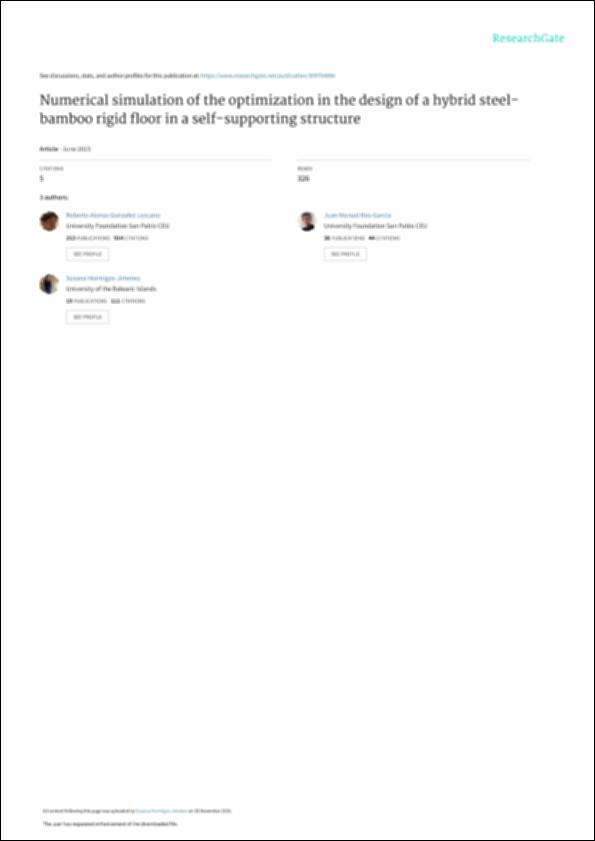Por favor, use este identificador para citar o enlazar este ítem:
http://hdl.handle.net/10637/15816Numerical simulation of the optimization in the design of a hybrid steel-bamboo rigid floor in a self-supporting structure
| Título : | Numerical simulation of the optimization in the design of a hybrid steel-bamboo rigid floor in a self-supporting structure |
| Autor : | González Lezcano, Roberto Alonso. Ros García, Juan Manuel Hormigos Jiménez, Susana |
| Materias: | Optimización estructural.; Simulación numérica; Numerical simulation; Structural behavior |
| Editorial : | Redalyc |
| Citación : | Gonzalez-Lezcano, Roberto Alonso & Ros-García, Juan & Hormigos-Jimenez, Susana. (2015). Numerical simulation of the optimization in the design of a hybrid steel-bamboo rigid floor in a self-supporting structure. El hombre y la máquina. 46. 89-105 |
| Resumen : | Partiendo de una estructura autoportante,
se pretende mostrar las
consideraciones y modificaciones de
diseño llevadas a cabo para desarrollar
la optimización de un suelo rígido
acero-bambú para dicha estructura. Se
justifica la elección de los materiales a
través de sus propiedades mecánicas y
coste, mostrando las ventajas del empleo
del bambú como material de construcción.
Con el propósito de lograr el
mejor resultado en la optimización del
modelo, se emplea como metodología
de trabajo la simulación numérica por
medio de elementos finitos utilizando el
software comercial Abaqus. Se llevan a
cabo distintas configuraciones dentro de
la estructura autoportante (empleando
elementos de refuerzo) y en la propia
configuración geométrica de los paneles
de bambú y de su soporte de acero, generando tres modelos diferentes (A, B y
C), de tal forma que sea posible, en las tres
opciones, elaborar un análisis que relacione
tanto los esfuerzos generados como el
desplazamiento y la deformación que sufre
la base sometida a estudio. Finalmente se
realiza una comparación de los resultados
obtenidos por medio de las simulaciones,
para concluir cuál de ellos consigue la
optimización más adecuada del modelo,
observándose cambios significativos en la
flecha y ciertas variaciones en los esfuerzos
internos. Considering a self-supporting structure, it is intended to show the considerations and modifications in the design which have been carried out to develop the optimization of a hybrid steel-bamboo rigid floor for the structure. The materials applied in the design of the floor, steel and bamboo, are chosen because of their mechanical properties and their cost. it is shown the benefits of using bamboo as building material. Due to reach the best result in the optimization of the model, it is used, as methodology, numerical simulations by finite elements using Abaqus software to obtain the structural behavior of the different elements. Several configurations are carried out in the self-supporting structure (using reinforced elements) and also it has been varied the geometric configuration of the bamboo panels and their steel support. According to those changes, three different models have been created (A, B and C) making possible, in every option, the analysis of the different generated stresses, the displacement and deformation suffered by the case study floor. Then, it has been carried out a comparison between all the results obtained by the numerical simulations according to changes in deflection and certain variations in stresses. Finally it has been concluded which model (A, B or C) reaches the most efficient optimization. |
| URI : | http://hdl.handle.net/10637/15816 |
| Derechos: | http://creativecommons.org/licenses/by-nc-nd/4.0/deed.es |
| ISSN : | 0121-0777 |
| Fecha de publicación : | jun-2015 |
| Centro : | Universidad San Pablo-CEU |
| Aparece en las colecciones: | Escuela de Politécnica Superior |
Los ítems de DSpace están protegidos por copyright, con todos los derechos reservados, a menos que se indique lo contrario.


